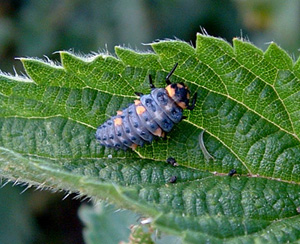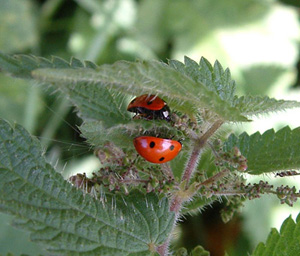Wildlife gardening - Ladybirds
Making a garden to attract ladybirds

Amazing fact about ladybird food
Think about this amazing fact: It is said that just one aphid, which ladybirds eat, if left to reproduce without being eaten by a predator, would produce 10 million tons of new aphids within 100 days, by parthenogenesis. Parthenogenesis means that aphids donít even need to mate because theyíre born pregnant!
But, a ladybird which lives for one year can eat more than 5,000 aphids in that time, so by not using pesticides you are feeding ladybirds. Provided that ladybirds get plenty of aphids to eat, they can lay up to 2,000 eggs in a year.
To make your garden wildlife friendly for ladybirds - do not use pesticides to kill aphids, this way the ladybirds will have something to eat.
Ladybirds are a true gardenerís friend and they, and their larvae, will eat aphids, red spider mite, whitefly and other pests.
Odd looking larvae
Ladybird larvae look very unlike the adults and may be mistaken for a pest. They are about half a centimetre long and have dark grey, segmented bodies with some yellow spots down each side. Make sure you know what they look like so you donít accidentally kill them.
How to help
You can help ladybirds by not spraying aphids and leaving them for the ladybirds to eat instead. Even if a plant is infested with aphids, donít panic - when the ladybirds find the plant they will eat them quickly and the plant should recover just as fast as if youíd sprayed it.

Ladybird larva on a nettle leaf

Ladybirds on nettles
Nettles
Nettles are a favourite egg laying plant for ladybirds and by leaving a patch of nettles to develop in your garden, you will be helping them to increase their numbers, and be able to watch the strange-looking larvae as well.
Hibernation
Ladybirds hibernate in as large a group as they can, sometimes in the thousands, so they keep each other warm. Sometimes you might find them clustered amongst the stems at the base of large ornamental grasses such as pampas grass. Growing clump-forming grasses will give ladybirds somewhere to hibernate, and they look attractive too.
Before cutting back or burning the grasses, make sure that it isnít full of ladybirds first! Wait till the weather has warmed up, and the ladybirds have woken from their winter sleep, and tend your grasses then.

© Copyright Miranda Hodgson 2007